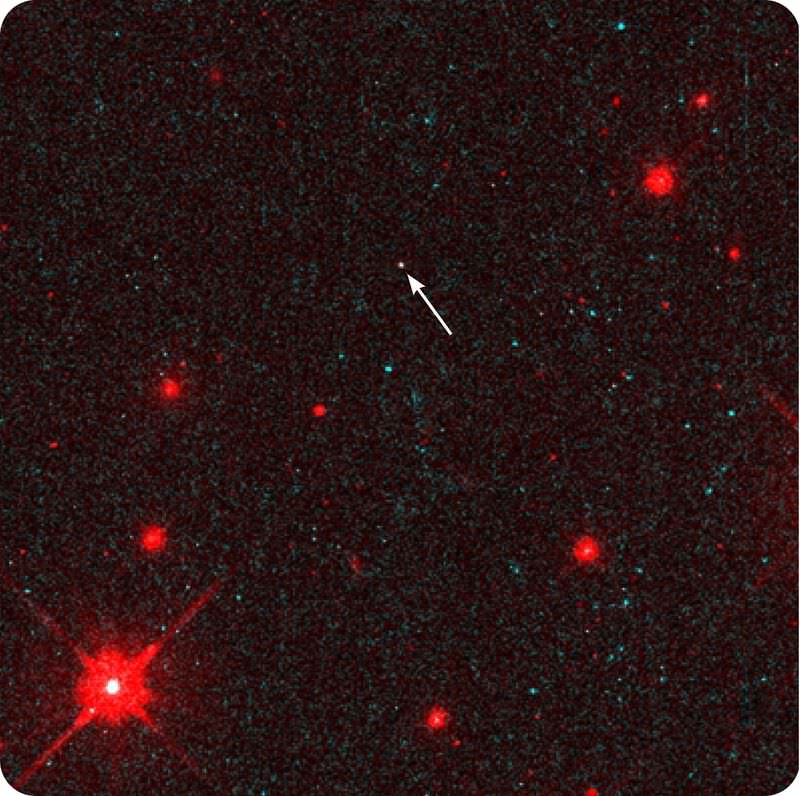中子
Section outline
-
The arrow in this photo is pointing to a star that doesn’t look like much compared with some of the other stars in the picture. It’s certainly much smaller than most other stars. In fact, it’s only about 20 kilometers in diameter. Compare that with the 1.4-million-kilometer diameter of our own sun. Despite its small size, however, this star has greater mass than the sun, making it incredibly dense. It also has tremendous gravity. In fact, gravity on its surface is about 2 × 10 11 times the gravity we feel on Earth! What type of star is it? It’s called a neutron star. That’s because it consists primarily of neutrons.
::这张照片中的箭头指向一颗恒星,它看起来不像照片中其他一些恒星那样大。它肯定比其他恒星要小得多。事实上,它直径只有大约20公里。与我们自己的太阳140万公里的直径相比,它只有大约20公里。然而,尽管这个恒星的体积小,但它的体积却比太阳大,使它变得异常稠密。它也有巨大的重力。事实上,其表面的重力是地球的重力的2×1011倍左右。它是什么类型的恒星?它被称为中子恒星。这是因为它主要由中子组成。What Is a Neutron?
::什么是中子?A neutron is one of three main particles that make up the . The other two particles are the and . Atoms of all elements—except for most atoms of hydrogen—have neutrons in their nucleus . The nucleus is the small, dense region at the center of an atom where protons are also found. Atoms generally have about the same number of neutrons as protons. For example, all carbon atoms have six protons and most also have six neutrons. A model of a carbon atom is shown in the Figure
::中子是构成该质子的三个主要粒子之一。另外两个粒子是所有元素的原子——除大多数氢原子外——在核心中都有中子。核心是原子中心的一个小密度区域,在原子的中心也发现了质子。原子的中子数量一般与质子大致相同。例如,所有碳原子有6个质子,大多数也有6个中子。图中显示了碳原子的模型。Properties of Neutrons
::中子属性Unlike protons and electrons, which are electrically charged, neutrons have no charge. In other words, they are electrically neutral. That’s why the neutrons in the diagram above are labeled n 0 . The zero stands for “zero charge.” The mass of a neutron is slightly greater than the mass of a proton, but both round to 1.0 atomic mass unit (amu). An atomic mass unit equals about 1.67 × 10 -27 kilograms. A neutron also has about the same diameter as a proton which is 1.7 × 10 -17 meters.
::与以电荷充电的质子和电子不同的是,中子没有电荷。换句话说,中子没有电荷。这就是上面图表中的中子被标注为N0的原因。零表示“零电荷 ” 。 中子的质量略高于质子的质量,但两者的重量都为1.0原子质量单位(AMu)。原子质量单位约等于1.67×10-27公斤。中子的直径也与质子大致相同,质子的直径为1.7×10-17米。Same Element, Different Numbers of Neutrons
::相同的元素, 不同的中子数All the atoms of a given have the same number of protons and electrons. The number of neutrons, however, may vary for atoms of the same element. For example, almost 99 percent of carbon atoms have six neutrons, but the rest have either seven or eight neutrons. Atoms of an element that differ in their numbers of neutrons are called isotopes. The nuclei of these isotopes of carbon are shown in the Figure . The called carbon-14 is used to find the ages of fossils.
::一个特定原子的所有质子数和电子数相同。 然而, 中子数可能因同元素的原子数而不同。 例如, 近99%的碳原子有6个中子, 其余的有7个或8个中子。 与其中子数不同的元素原子称为同位素。 图中显示了这些碳同位素的核。 所谓的碳-14用来查找化石的年代。Q: Notice the names of the carbon isotopes in the diagram. Based on this example, infer how isotopes of an element are named.
::问题:注意图表中的碳同位素名称。根据此示例,推断元素的同位素名称。A: Isotopes of an element are named for their total number of protons and neutrons.
::A:元素的同位素按质子和中子总数命名。Q: The element oxygen has 8 protons. How many protons and neutrons are there in oxygen-17?
::问题:元素氧有8个质子。氧气-17中有多少质子和中子?A: Oxygen-17—like all atoms of oxygen—has 8 protons. Its name provides the clue that it has a total of 17 protons and neutrons. Therefore, it must have 9 neutrons (8 + 9 = 17).
::甲:氧-17-类似于所有氧原子-有8个质子,其名称提供了它共有17个质子和中子的线索,因此,它必须有9个中子(8+9=17)。Particles in Neutrons
::中子中的粒子Neutrons consist of known as quarks and gluons. Each neutron contains three quarks, as shown in the diagram below. Two of the quarks are called down quarks (d) and the third quark is called an up quark (u). Gluons (represented by wavy yellow lines in the diagram) are fundamental particles that are given off or absorbed by quarks. They carry the strong nuclear force that holds together quarks in a neutron.
::中子由夸克和格伦组成。每个中子包含三个夸克,如下图所示。其中两个夸克被调低 夸克 (d) ,第三个夸克被调高 夸克 (u) 。 格伦斯(在图中以 wavy 黄色线为代表) 是基质颗粒, 由夸克提供或吸收。 它们携带强大的核力量, 将夸克放在中子中。Summary
::摘要-
A neutron is one of three main particles that make up the atom. It is found in the nucleus and is neutral in electric charge. It has about the same mass and diameter as a proton. Neutrons are found in all atoms except for most atoms of hydrogen.
::中子是构成原子的三个主要粒子之一。 它在核中被发现,在电荷中是中性的。 它与质子的重量和直径大致相同。 在所有原子中都发现了中子,但大多数氢原子除外。 -
All the atoms of a given element have the same number of protons and electrons, but they may vary in their numbers of neutrons. Atoms of the same element that differ in their numbers of neutrons are called isotopes.
::某一元素的所有原子的质子和电子数量相同,但它们的中子数量可能不同,而中子数量不同的原子则称为同位素。 -
Neutrons consist of fundamental particles known as quarks and gluons. Gluons carry the strong nuclear force that binds together the quarks in a neutron.
::中子由被称为夸克和格伦的基本粒子组成。格伦斯携带强大的核力量,将夸克结合成中子。
Review
::回顾-
What is a neutron?
::什么是中子? -
Compare and contrast neutrons and protons.
::比较和对比中子和质子 -
Explain how isotopes of an element differ from one another. Give an example.
::解释一个元素的同位素如何彼此不同。请举例说明。 -
Identify the fundamental particles that make up a neutron.
::识别构成中子的基本粒子。
Resources
::资源 -
A neutron is one of three main particles that make up the atom. It is found in the nucleus and is neutral in electric charge. It has about the same mass and diameter as a proton. Neutrons are found in all atoms except for most atoms of hydrogen.



